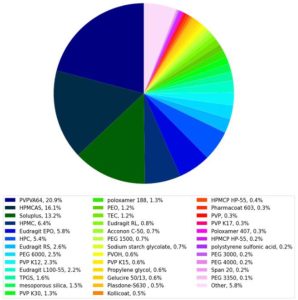The applications of machine learning to predict the forming of chemically stable amorphous solid dispersions prepared by hot-melt extrusion

Amorphous solid dispersion (ASD) is one of the most important strategies to improve the solubility and dissolution rate of poorly water-soluble drugs. As a widely used technique to prepare ASDs, hot-melt extrusion (HME) provides various benefits, including a solvent-free process, continuous manufacturing, and efficient mixing compared to solvent-based methods, such as spray drying. Energy input, consisting of thermal and specific mechanical energy, should be carefully controlled during the HME process to prevent chemical degradation and residual crystallinity. However, a conventional ASD development process uses a trial-and-error approach, which is laborious and time-consuming.
In this study, we have successfully built multiple machine learning (ML) models to predict the amorphization of crystalline drug formulations and the chemical stability of subsequent ASDs prepared by the HME process. We utilized 760 formulations containing 49 active pharmaceutical ingredients (APIs) and 38 excipients. By evaluating the built ML models, we found that ECFP-LightGBM was the best model to predict amorphization with an accuracy of 92.8%. Furthermore, ECFP-XGBoost was the best in estimating chemical stability with an accuracy of 96.0%.
In addition, the feature importance analyses based on SHapley Additive exPlanations (SHAP) and information gain (IG) revealed that several processing parameters and material attributes (i.e., drug loading, polymer ratio, drug’s Extended-connectivity fingerprints (ECFP) fingerprints, and polymer’s properties) are critical for achieving accurate predictions for the selected models. Moreover, important API’s substructures related to amorphization and chemical stability were determined, and the results are largely consistent with the literature.

Figure 1: A brief description of the APIs and excipients used in this study. The pie charts show the categories and the corresponding proportions of APIs (Left) and excipients (Right) used for ML modeling. According to the data exploratory analysis by the pie charts, itraconazole, felodipine, and nifedipine are three of the most widely used drugs in the dataset collected from the published literature with portions of 8.7%, 7.9%, and 7.8%, respectively. For excipients, polyvinylpyrrolidone (PVPVA64), hypromellose acetate succinate (HPMCAS), and polyvinyl caprolactam polyvinyl acetate-polyethylene glycol graft copolymer (Soluplus) were the top 3 most popular excipients in the obtained dataset.
In conclusion, we established the ML models to predict formation of chemically stable ASDs and identify the critical attributes during HME processing. Importantly, the developed ML methodology has the potential to facilitate the product development of ASDs manufactured by HME with a much reduced human workload.
Download the full article as PDF here The applications of machine learning to predict the forming of chemically stable amorphous solid dispersions prepared by hot-melt extrusion
or read it here
Junhuang Jiang, Anqi Lu, Xiangyu Ma, Defang Ouyang, Robert O. Williams, The applications of machine learning to predict the forming of chemically stable amorphous solid dispersions prepared by hot-melt extrusion, International Journal of Pharmaceutics: X, 2023, 100164, ISSN 2590-1567, https://doi.org/10.1016/j.ijpx.2023.100164.

